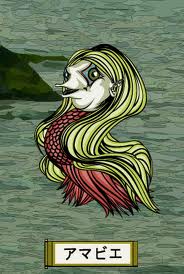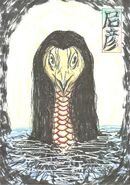No edit summary Tag: rte-source |
(Adding categories) |
||
| Line 36: | Line 36: | ||
*[https://en.wikipedia.org/wiki/Amabie Amabie] on Wikipedia |
*[https://en.wikipedia.org/wiki/Amabie Amabie] on Wikipedia |
||
[[Category:Yōkai]] |
[[Category:Yōkai]] |
||
| + | [[Category:Aquatic]] |
||
Revision as of 20:02, 6 December 2018
| Amabie | ||
 | ||
| Information | ||
|---|---|---|
| Romanized | Amabie | |
| Kanji | アマビエ | |
| Other names | Amabiko, Amahiko, Amahiko-Nyūdo, Arie | |
| Type | Unknown | |
| Places | Kumamoto Prefecture, Miyazaki Prefecture | |
Amabie' (アマビエ, Amabie) is a legendary Japanese mermaid who allegedly emerges from the sea and prophesies either an abundant harvest or an epidemic. There are other mermaids and mermen known by other names but considered identical. The male Amabiko (アマビコ, 天日子) or Amahiko (尼彦, あま彦, 天彦), Amahiko-Nyūdo (尼彦入道), and the elusive Arie (アリエ).
Description
Amabie appeared in Higo Province (Kumamoto Prefecture) according to legend, around the middle of the 4th month, in the year Kōka-3 (mid-May, 1846) in the Edo era. A glowing object had been spotted in the sea, almost on a nightly basis. The town's official went to the coast to investigate, and witnessed the amabie. She had a mouth like bird's bill, and was covered in scales from the neck down. Addressing the official, she identified herself as an amabie and told him that she lived in the open sea. She went on to deliver a prophecy: "Good harvest will continue for six years, if disease spreads show a picture of me to those who fall ill and they will be cured." Afterwards, she returned the sea. The story was printed in the kawaraban (woodblock-printed bulletins), where her likeness was printed, and this is how the story disseminated in Japan.
A yōkai creature considered identical to Amabie is the merman named Amahiko (尼彦), which reputedly appeared in the sea of Higo Province. This Amahiko resembled Amabie in that it also made predictions of bountiful harvests or pestilence, and prescribed displaying the picture of his likeness in order to avoid catastrophe. The Amahiko Nyūdo (尼彦入道, "the amahiko monk") of Hyuga Province (Miyazaki Prefecture) was another creature considered of the same kind, who appeared and pronounced his prophecy.
A similar creature named Arie (アリエ) appeared in "Aoshima-gun" county, Higo Province, according to the Yamanashi Nichinichi Shinbun newspaper dated 17 June 1876, although this report has been debunked by another paper. The Yūbin Hōchi Shinbun dated 10 June 1876 also carried an article about Amahiko.
The three creatures share these common characteristics: 1) appearance from the sea, 2) prediction of good harvest and the plague, and 3) a solution of disaster by showing the apparition's picture, and on that account have been considered identical.
The Amahiko no Mikoto (天日子尊 the holly Amahiko) was spotted in a rice paddy in Yuzawa, Niigata, as reported by the Tokyo Nichinichi shinbun dated 8 August 1875. The yamawarawa (山童 the mountain child) in the folklore of Amakusa is believed to haunt the mountains. Although neither of these last two emerge from sea, other similarities such as prophesying indicate they belong to the same kind.
A tradition in the West ascribes every creature of the sea with the ability to foretell the future, and there is no scarcity of European legends about merfolk bringing prophecy. For this reason, the amabie is considered to be a type of mermaid, in some quarters. But since the amabie is credited with the ability to repel pestilence as well, it should be considered as more of a deity according to some.
There are various other yōkai creatures that are vastly different in appearance, but have the ability to predict, such as the kudan, the jinjahime or "shrine princess", the hōnen game (豊年亀) or "bumper crop year turtle", and the "turtle woman".
On the amabie, there is only one record of it, and the meaning of its name is uncertain. It has therefore been conjectured to be a mere mistranscription of "ambiko" as "amabie" (because the Japanese letters ko (コ) and e (エ) are nearly interchangeably similar).
Gallery
References
- Amabie on Wikipedia

